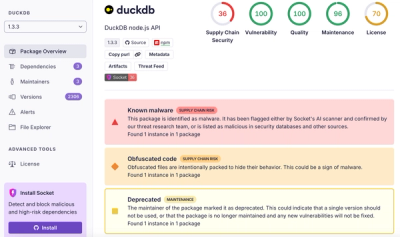
Product
Introducing Tier 1 Reachability: Precision CVE Triage for Enterprise Teams
Socket’s new Tier 1 Reachability filters out up to 80% of irrelevant CVEs, so security teams can focus on the vulnerabilities that matter.
node-twitter-api
Advanced tools
Simple module for using Twitter's API in node.js
npm install node-twitter-api
var twitterAPI = require('node-twitter-api');
var twitter = new twitterAPI({
consumerKey: 'your consumer Key',
consumerSecret: 'your consumer secret',
callback: 'http://yoururl.tld/something'
});
Optionally you can add x_auth_access_type: "read" or x_auth_access_type: "write" (see: https://dev.twitter.com/oauth/reference/post/oauth/request_token).
twitter.getRequestToken(function(error, requestToken, requestTokenSecret, results){
if (error) {
console.log("Error getting OAuth request token : " + error);
} else {
//store token and tokenSecret somewhere, you'll need them later; redirect user
}
});
If no error has occured, you now have a requestToken and a requestTokenSecret. You should store them somewhere (e.g. in a session, if you are using express), because you will need them later to get the current user's access token, which is used for authentification.
Redirect the user to https://twitter.com/oauth/authenticate?oauth_token=[requestToken]. twitter.getAuthUrl(requestToken, options) also returns that URL (the options parameter is optional and may contain a boolean force_login and a String screen_name - see the Twitter API Documentation for more information on these parameters).
If he allows your app to access his data, Twitter will redirect him to your callback-URL (defined in Step 1) containing the get-parameters: oauth_token and oauth_verifier. You can use oauth_token (which is the requestToken in Step 2) to find the associated requestTokenSecret. You will need requestToken, requestTokenSecret and oauth_verifier to get an Access Token.
twitter.getAccessToken(requestToken, requestTokenSecret, oauth_verifier, function(error, accessToken, accessTokenSecret, results) {
if (error) {
console.log(error);
} else {
//store accessToken and accessTokenSecret somewhere (associated to the user)
//Step 4: Verify Credentials belongs here
}
});
If no error occured, you now have an accessToken and an accessTokenSecret. You need them to authenticate later API-calls.
twitter.verifyCredentials(accessToken, accessTokenSecret, params, function(error, data, response) {
if (error) {
//something was wrong with either accessToken or accessTokenSecret
//start over with Step 1
} else {
//accessToken and accessTokenSecret can now be used to make api-calls (not yet implemented)
//data contains the user-data described in the official Twitter-API-docs
//you could e.g. display his screen_name
console.log(data["screen_name"]);
}
});
In the above example, params is an optional object containing extra parameters to be sent to the Twitter endpoint (see https://dev.twitter.com/rest/reference/get/account/verify_credentials)
(Allmost) all function names replicate the endpoints of the Twitter API 1.1. If you want to post a status e. g. - which is done by posting data to statuses/update - you can just do the following:
twitter.statuses("update", {
status: "Hello world!"
},
accessToken,
accessTokenSecret,
function(error, data, response) {
if (error) {
// something went wrong
} else {
// data contains the data sent by twitter
}
}
);
Most of the functions use the scheme:
twitter.[namespace]([type], [params], [accessToken], [accessTokenSecret], [callback]);
For Timelines you can also use the function getTimeline which has the following types:
user or user_timeline (Note that you need to either specify user_id or screen_name when using this timeline)home or home_timelinementions or mentions_timelineretweets or retweets_of_meFor more information on the different types of timelines see https://dev.twitter.com/rest/reference/get/statuses/home_timeline (analog for the other types)
For Streams you must use getStream which has two instead of just one callback: a dataCallback and an endCallback. (c.f. data and end events of node's http response)
To upload media to Twitter, call twitter.uploadMedia(params, accessToken, accessTokenSecret, callback) with params containing the following:
To upload video to Twitter, call twitter.uploadVideo(params, accessToken, accessTokenSecret, callback) with params containing the following:
You can pass media_id to the statuses/update endpoint and video will be uploaded to twitter. Please note that video should be less than 15mb or 30 sec in length.
FAQs
Simple module for using Twitter's API in node.js
The npm package node-twitter-api receives a total of 1,282 weekly downloads. As such, node-twitter-api popularity was classified as popular.
We found that node-twitter-api demonstrated a not healthy version release cadence and project activity because the last version was released a year ago. It has 1 open source maintainer collaborating on the project.
Did you know?

Socket for GitHub automatically highlights issues in each pull request and monitors the health of all your open source dependencies. Discover the contents of your packages and block harmful activity before you install or update your dependencies.

Product
Socket’s new Tier 1 Reachability filters out up to 80% of irrelevant CVEs, so security teams can focus on the vulnerabilities that matter.

Research
/Security News
Ongoing npm supply chain attack spreads to DuckDB: multiple packages compromised with the same wallet-drainer malware.

Security News
The MCP Steering Committee has launched the official MCP Registry in preview, a central hub for discovering and publishing MCP servers.